How to get your clients back: why you shouldn’t let go if you love them

I bet you have your own “gone customers’ cemetery” of those who once were with you, but have gone and are not planning to return. It’s sad, but you can’t give up: almost half of them are sure to be returned.
If a person has interacted with you, they are at least a little interested. Your task is to identify what has affected their trust, make an effort and find out how to get former customers back.
How do you know when it’s time for action?
There are two key indicators that provide insights into how you are doing with your current customers. They are interrelated and we have talked a lot about them; they are Churn and Retention rates.
Churn is those users who have stopped any interaction with you.
Retention is your ability to maintain a long-term relationship with your customers.
You need to understand that no one is perfect; there will always be users who have not obtained the benefits and left you. This indicator needs to be monitored and acted upon when it gets out of control. This is how the churn rate is calculated:

It’s hard to say what churn rate can be considered acceptable. Much depends on the age of the company: in startups, for example, the churn rate is the main issue as it can reach 15%. Gradually, the product finds its audience, and the churn rate decreases.
It is commonly considered that for SaaS services, the churn rate should not exceed 3%. If you have been working for a long time, and the churn rate is large or even worse, if it’s growing period by period, it’s time to take urgent action.
The work on customer retention is also a very important process. It is known that existing customers are ready to spend 67% more than new ones. According to the research conducted by Price Intelligently, a 1% increase in the retention rate leads to a 7% increase in profits. There are many ways to retain customers; the most effective for you can only be determined through experience. You should always keep an eye on that metric.
What customers should be returned?
It will not be possible to return the client in the snap of a finger: it takes strength, time, and budget. It may happen that you spend a lot, but get a little; the returned client will not pay off themselves. In order not to waste resources, you need to understand who to return, and whom to say goodbye once and for all.
The MarketingProfs team has conducted research to find out which customers should be returned. To do this, they divided all the churn customers into two groups: quick-churn and late-churn. The first group included users who had only been working with the service for a short time and had never become regular customers. The second group was those who actively interacted (extended the subscription, contacted customer support, opted in for additional functions).
The results have shown that newcomers are more difficult to return than users who were active in the past: 29% of the first group returned, whereas 53% of the second group got back. Among those who returned, the “old” is 51% more active than the “newcomers”. It turns out that you make the same effort to return both categories, but the results are different. It makes sense to group lost customers by their activity and the duration of interaction with you, and build a return campaign depending on it.
Read more
- 10 Best Live Chat Software for Customer Support
- 10 Best Customer Service Chatbot Platforms to Level Up the Work
- How to create a user journey online map for your online school students [4 free templates]
- Increase Customer Support Efficiency With 15 Best Knowledge Base Tools
- Chatbot Guide: What can a chatbot do for your customers 24/7
Figuring out the reasons
Before taking action to get the customer back, you need to understand why they left. If they decide that they no longer need your service, trying to sell the same instruments for less is unlikely to work. There are several ways to determine the user’s motive.
Fullstory is a service that allows you to look at your website through the eyes of the user. You can completely track their actions: what sections they look at, where they stop, even how they move the mouse. With its help, you can easily understand what on the website gets your customers interested and where they have difficulties.
Fullstory also allows you to determine where on the website something broke down or what a customer didn’t like. For example, you can see the buttons that drove the user crazy (they quickly clicked many times on the same place). The report looks like this:
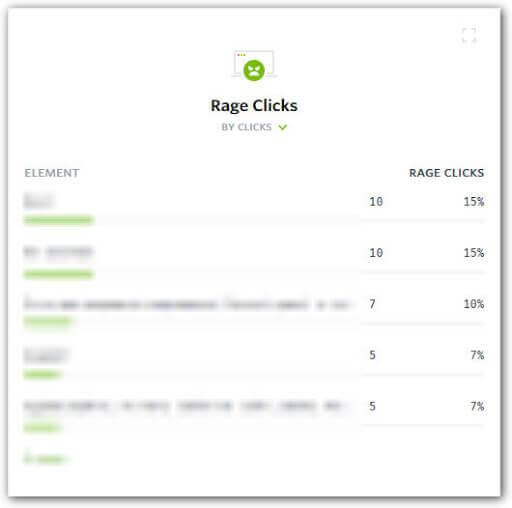
Emails are a good way with one very serious flaw. In an email, you can explain the situation, pose a question, start a dialogue, but only in the most daring fantasies of marketers it is opened by absolutely all recipients. In fact, the open rate of about 20% is already fine, although it turns out that the letter was read by only a fifth of the users. An automatic message in a website chat is a good way to get in touch with a user who hasn’t visited you in a while and returned. Everybody is used to seeing this standard “Hello, how can I help you?” message in the chat window, so something new is likely to attract attention.
To make your messages more personalized, you can set up user segmentation in the Dashly online chat. For example, you can only start a dialogue with those who haven’t visited you in 2 days, or those who have added things to the shopping cart.
A phone call is probably the most effective way, though expensive. By phone, you can find out what did not fit the customer, what they wanted to change, to make them an offer. In the course of the conversation, you will understand the mood of your interlocutor in general, learn about their problems, and offer a personalized solution.
Gather responses of your customers and analyze them. If several customers confess they lack a certain function, it is worth implementing it.
Read also:
⭐ Sales Funnel Emails for 2025: Create, Automate, and Convert [11 Case Studies]
⭐ 6 Steps to Identify and Repair Your Leaky Funnel for Better Conversions
How to get lost customers back?
Finally, the fun part. You know it’s time to take action, but it’s not clear which one. There are many different ways to restore the love of the customers; we will discuss the most effective of them in our opinion.
Apologize sincerely
A small percentage of users go away for no reason; there’s usually a good reason for that, and you might have screwed up somewhere. Try a proven remedy — apologize sincerely. For example, you can describe the situation in an email or discuss it over the phone. This method works well with those customers who have been with you for a long time, especially if you know each other personally.

Read also:
Capture emails from website visitors with Pop-ups
The best way to collect emails we tested this year
The North Star Metric and How Can This Lead to Success
Start a dialogue
Run a special email newsletter to return customers. You can design it as you wish, for example, insert a questionnaire, survey, video message. The essence of it is to bring the user to a dialog, to find out what is the reason for their rejection of you.
Standard emails with the subject “We miss you” aren’t working well anymore. You need to give the impression that you are writing a personal email address to a specific person, rather than just sending out emails throughout your contact list.
Offer the recipient something useful: it will attract attention and motivate them to respond (perhaps you will get an answer where they at least thank you).
The Blue Apron meal kit delivery service is sending such emails to those customers who haven’t ordered within a week:
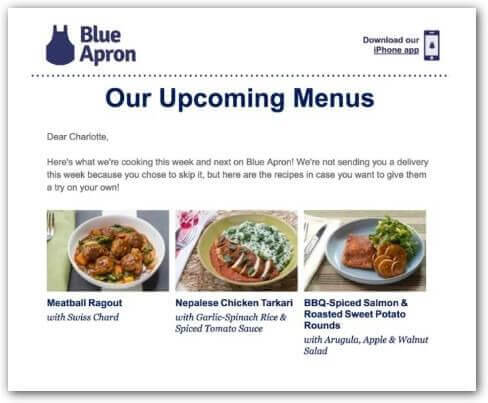
In the email, they offer recipes based on previous orders of this user. Adding an invitation to dialogue here will make it a great return email.
Make a present
Sometimes a user needs to be “bribed” to come back to you. Offer a promo code, a gift, free delivery, or anything else valuable.
But be careful with discounts. According to Patrick Campbell, the expert from Price Intelligently, too-high discounts devalue your product in the eyes of the customer and also have a tangible negative impact on LTV.
If you find out that a customer lacks some feature they found in a competitor, implement it. Of course, not everyone will like it, but if you noticed that several users need something at once, it makes sense to make an effort and create this function.
And one more thing: don’t promise something you can’t or won’t do. Otherwise, you’ll bury yourself even deeper.
Offer something new
If you’ve released some cool updates, don’t be silent about it in any way. Write an article, set up a webinar, or tell about it in an email, and try to attract as many former customers as possible. It is likely that they will be interested in your changes, perhaps they were just waiting for them! It’s definitely worth testing this method.
Read also: how to find respondents for a survey or customer interview
Remind about important things
This is rather a preventative measure, but it’s better to overdo something than to not do enough. Set up notifications to let users know when they need to top up their balance, about features that are not connected, and about updates that have been released.
Sometimes customers forget and score: the subscription ends, they do not get a hand to extend it, then they are somehow distracted and do not come back at all. It is a shame to lose a user just because of inattention, so be sure to inform him that the time of payment is close.
Sometimes customers forget and skip out on things: their subscription ends, they don’t have time to extend it; then, they get distracted and do not get back at all. It’s a shame to lose a user just because of their inattention, so be sure to inform them that the payment time is close.
For example, we have done this pop-up in the constructor: it reminds users that they are about to lose their access to the platform.

Make great content
I’m sure you still have your customer’s contacts; keep sending emails to them. It is important not to become annoying: one email per week is definitely enough. Here’s another rule: allocate the minimum amount of email space for advertising; your current task is not to sell faster, but to return the attention of a departed customer.
Offer them interesting articles, entertain them with hilarious and appropriate (!) stories, share the news with them, and delicately direct them to your website.
Read also: Find out the best Intercom alternatives and Drift alternative
Getting gone customers back: learning by examples
Netpeak has made a great chain of emails. If one day you decide to download a trial of one of their services, and then do not buy a subscription, here’s what awaits you.
First, the charming girl wonders why you stopped using the service.
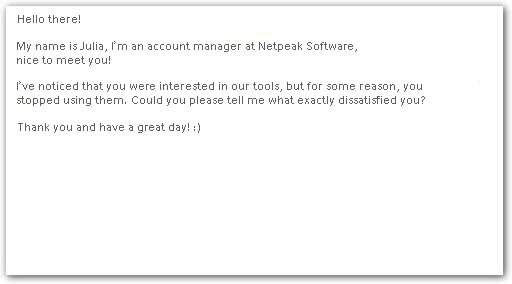
Let’s say you’re not taking this email seriously and you’re not responding to it. In 2 weeks, Julia writes again.
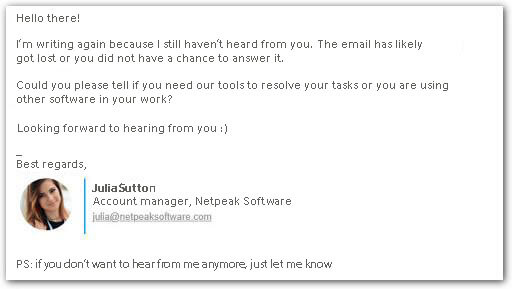
You start feeling awkward not answering Julia and you write her that the tool was needed for a certain task, now it has been solved and the need has disappeared, but maybe after a while, it will appear again.
Julia is glad you finally showed the signs of life, and she writes:
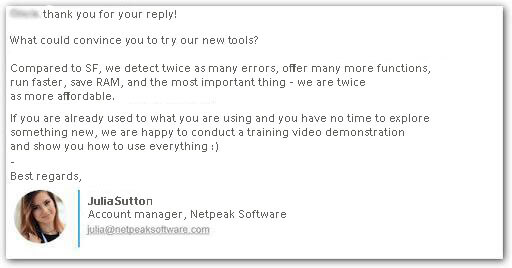
The email refers to the service we mentioned in the reply. It turns out that you are first brought into a dialogue, then told more about yourself and offer value (help). The best part is that the letters look personal, as if the company manager is really writing to you. Of course, all e-mails prior to your first response are sent automatically, but you have to admit that this is not obvious.
SE Ranking service sends such an email to users who have not renewed their subscription:

You are reminded that your subscription has expired and all indispensable features of the service are no longer available. Then they offer you a promotional code for a 20% discount and lead you back to the website. The friendly tone of the email and the author’s photo convert a user to return to the website.
Social networks taught us 10 years ago: “If you love it, let it go”, but it doesn’t always work. You can and should return gone users; the main thing is to do it correctly. Determine who should be returned, contact them, and don’t be intrusive. And then you will get back what is truly yours.
Read also:
- Customer VS Client — making the difference clear
- Why eCommerce and omnichannel are inseparable?
- How to qualify lead within sales and marketing teams
- Ultimate guide to inbound lead qualification in EdTech marketing
- How to Qualify and Collect More Leads with Lead Bot?
- How BANT sales process can help you get qualified SQL in 2022


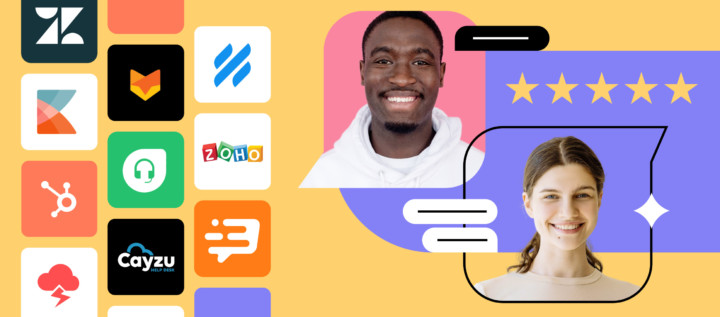
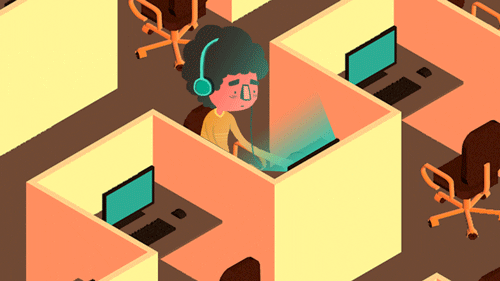
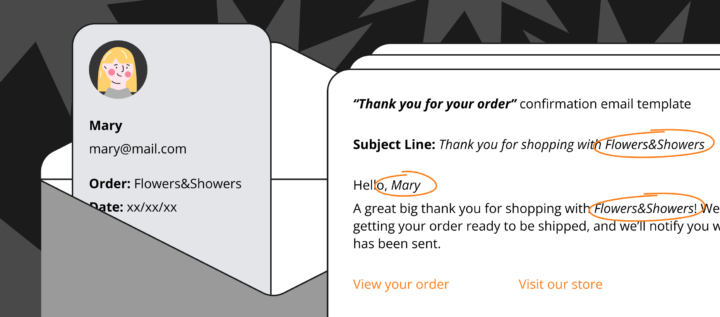
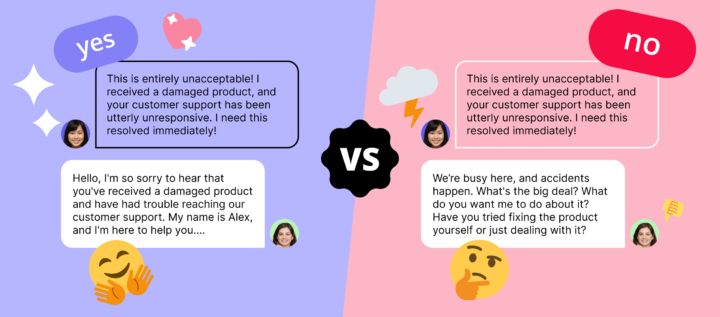
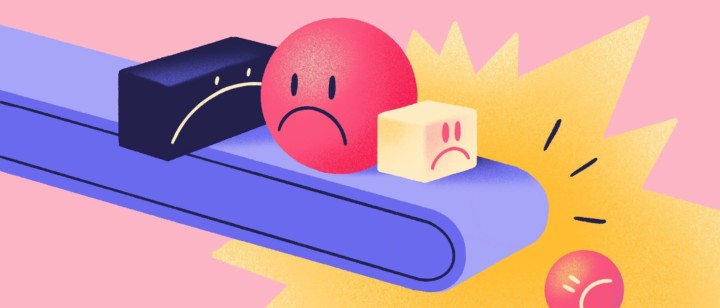
![12 Mistakes When Choosing Live Chat, Users Regret About [Based On Capterra Reviews]](https://www.dashly.io/blog/wp-content/uploads/2021/03/live-chat-mistakes-720x308.jpg)